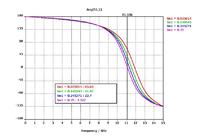Pushhead
Full Member level 4
Hi,
I'm glad that it works for you. The diffrences you see can be the result of many things like solver settings, mesh setting etc.
If you'll post your model and the article you are trying to follow i'll be able to give it a dipper inspection.
rgdz,
P.
I'm glad that it works for you. The diffrences you see can be the result of many things like solver settings, mesh setting etc.
If you'll post your model and the article you are trying to follow i'll be able to give it a dipper inspection.
rgdz,
P.
